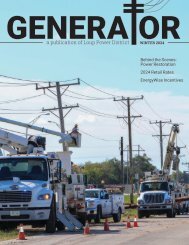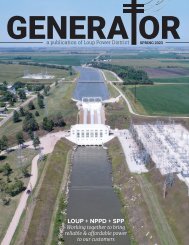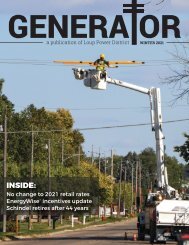Loup Generator — Winter 2022
Learn more about the invasive species in Nebraska and what you can do if you spot them. The 2022 list of financial incentives available to customers who make energy-efficient upgrades. Also in this issue, Mini-Splits 101: an introduction for homeowners.
Learn more about the invasive species in Nebraska and what you can do if you spot them. The 2022 list of financial incentives available to customers who make energy-efficient upgrades. Also in this issue, Mini-Splits 101: an introduction for homeowners.
Create successful ePaper yourself
Turn your PDF publications into a flip-book with our unique Google optimized e-Paper software.
PURPLE<br />
LOOSESTRIFE<br />
Lythrum salicaria<br />
Height: up to 8'<br />
Blooms: July through September<br />
Identification: Pink-purple flowers; heartshaped<br />
leaves<br />
Known locations: Widespread throughout<br />
Nebraska, especially in the east along the<br />
Platte and Niobrara Rivers<br />
Birthplace: Introduced from Europe as an<br />
ornamental for landscaping<br />
Crimes: Spreads by resprouting from stem<br />
cuttings and pieces of root stock; longliving<br />
seeds disperse by wind and water,<br />
and can adhere to wildlife, livestock,<br />
people, tires, boats, etc.; forms dense<br />
stands over very large areas, restricting<br />
water movement, trapping sediment and<br />
causing changes in water quality; adapts<br />
to many environments and competes with<br />
native vegetation<br />
PLUMELESS<br />
THISTLE<br />
Carduus acanthoides<br />
Height: up to 4'<br />
Flowers: June to August<br />
Identification: Purple clustered<br />
or solitary flowers; spiny stem (unlike<br />
musk thistle which has a spineless stem<br />
area); spiny leaves; hairs at the tip<br />
Known locations: Widespread in pastures,<br />
rangeland, non-crop areas, and roadsides<br />
<strong>—</strong> especially in Northeast Nebraska<br />
Birthplace: Eurasia<br />
Crimes: Serves as a food source for butterflies<br />
and songbirds; spreads primarily by<br />
wind-driven seed distribution; thousands<br />
of dollars lost in Nebraska agricultural<br />
production annually; competes with native<br />
vegetation<br />
COMMON REED<br />
GRASS<br />
Phragmites australis<br />
Height: up to 20'<br />
Seeds: July through September<br />
Identification: yellow-green leaves<br />
contrast with gray-green foliage of many<br />
native reed grasses<br />
Known locations: Marshes, floodplains,<br />
ditches, ponds, waterways throughout<br />
Nebraska, especially along the Platte River<br />
Birthplace: Introduced from Europe for<br />
erosion control<br />
Crimes: Spreads by extensive rhizomes<br />
and seed dispersal; inadvertently transported<br />
by boats and other recreational<br />
equipment such as duck blinds and<br />
decoys; forms dense stands over very<br />
large areas, restricting water movement,<br />
trapping sediment and causing changes<br />
in water quality; severe infestations<br />
will dominate waters; adapts to many<br />
environments and competes with native<br />
vegetation<br />
Bighead Carp<br />
Crimes: These invasive carp are aggressive,<br />
fast-growing, and prolific feeders that<br />
out-compete native fish and leave a trail<br />
of environmental destruction in their wake<br />
Black Carp<br />
For more information about invasive<br />
carp, visit neinvasives.com and<br />
outdoor nebraska.gov.<br />
Fish photos by Ryan Hagerty/USFWS.<br />
Thanks to MIke Gutzmer for information.<br />
WINTER <strong>2022</strong> | 9
















